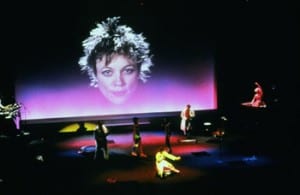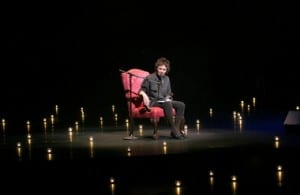Laurie Anderson is proving to be a very influential practitioner. Her use of short stories, music and technology has landed her right in the center of my research. After changing my mind numerous times, I have decided to perform an autobiographical piece based on the impact my family and relationship have on my career aspirations. Whilst researching her performance techniques I stumbled across an interview where Laurie herself summed up my performance in one simply sentence:
When asked, what does love feel like? Laurie replied ‘freedom and stillness. Lack of striving. Contentment’ (Greenstreet, 2015)
This phrase captures exactly the struggle that I want to portray. How the things you love most can sometimes be the things that can, physically and mentally, hold you back.
Anderson’s performances are often packed full of out of this world technological spectacles, dancers in eye-catching costumes and striking sets. Although I can appreciate how successful this theatrical construction was, I feel that it could sometimes overpower her social commentary and underlying stories. John O’Mahony commented that in more recent productions, Anderson’s work has become more reserved and focuses on the social commentaries and the music itself as opposed to the spectacle. Dirtday! (2012) ‘has little of her trademark back-projected hi-tec wizardry. [Suggesting that] those things get in the way of the music’ (O’Mahony, 2009). Although I shall take influence from Anderson’s earlier musical performances, I wish to stage my performance more simply like her later work so there are little distractions to the story.
^ Original eccentric staging ^ More recent relaxed staging.
It is easy to get swept up in the musical spectacle, and overlook her extraordinary storytelling ability. ‘What people really love about Laurie Anderson are the stories she tells, and the way she tells them’ (McDaid, 2008). Many of her performances are social commentaries on current social situations, however the way she tells them, with her soft lullaby-like vocals, captures the audience and draws them into the story more. The way she speaks is beautifully poetic. The language she uses paints a picture that captures the audience through its abstract metaphors, using ironicaly beautiful words to describe a not-so-beautiful topic. This is something that I want to incorporate into the spoken part of my piece. Providing the audience with not only a physical picture of my situation, but a chance to create their own picture in their imaginations through the use of language.
Storytelling ability aside, it is undeniable that Laurie Anderson is most famous for her music. What makes her work stand out from other musical performance art is her avant-garde approach to music and sound. For example, The Afternoon of Automotive Transmission (1972), which was a symphony of car horns held in a park. The making of music from everyday objects is something I really like of Anderson’s work. In my performance I want to be tied down by three materials (chains, rope, wire, etc.) from which I will create sounds. These sounds will then be layered on top of one another to create a musical track. One idea is to be restrained by wire, which I would then play with a violin bow.
Like Anderson, I really enjoy minimalism in terms of music and I want to focus on avant-garde music as opposed to the standard structured song. Walt Whitman once rightly stated that ‘simplicity is the glory of expression’ (Whitman and Reynolds, 2005, 12). I want to use the loop system to create minimalistic sounds that then can be placed onto of one another to create a complex score of metaphorical music.
Work cited
Greenstreet, R. (2015) Q&A: Laurie Anderson. [online] London: The Guardian. Available from http://www.theguardian.com/lifeandstyle/2015/may/16/laurie-anderson-interview [Accessed 20 February 2016].
McDaid, C. (2008) Storytime with knobs on. [online] London: The Guardian. Available from http://www.theguardian.com/music/2008/may/04/popandrock3 [Accessed 19 February 2016].
O’Mahony, J. (2008) Adults are idiots. [online] London: The Guardian. Available from http://www.theguardian.com/music/2008/apr/07/electronicmusic.art [Accessed 20 February 2016].
Whitman, W., Reynolds, D, S. (2005) Leaves of Grass. Oxford: Oxford University Press.


